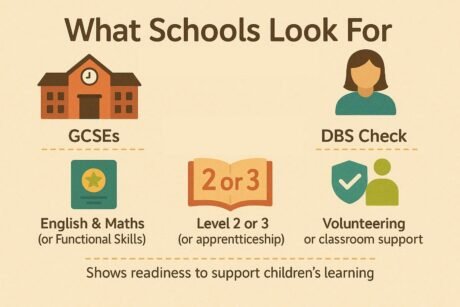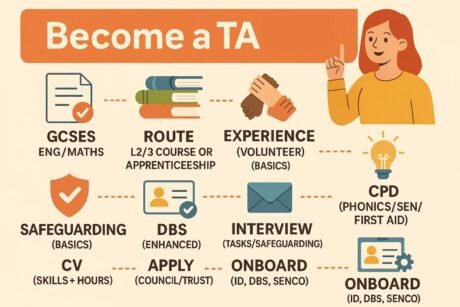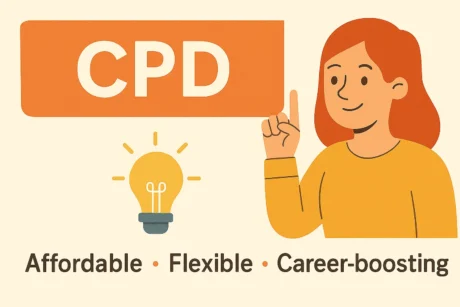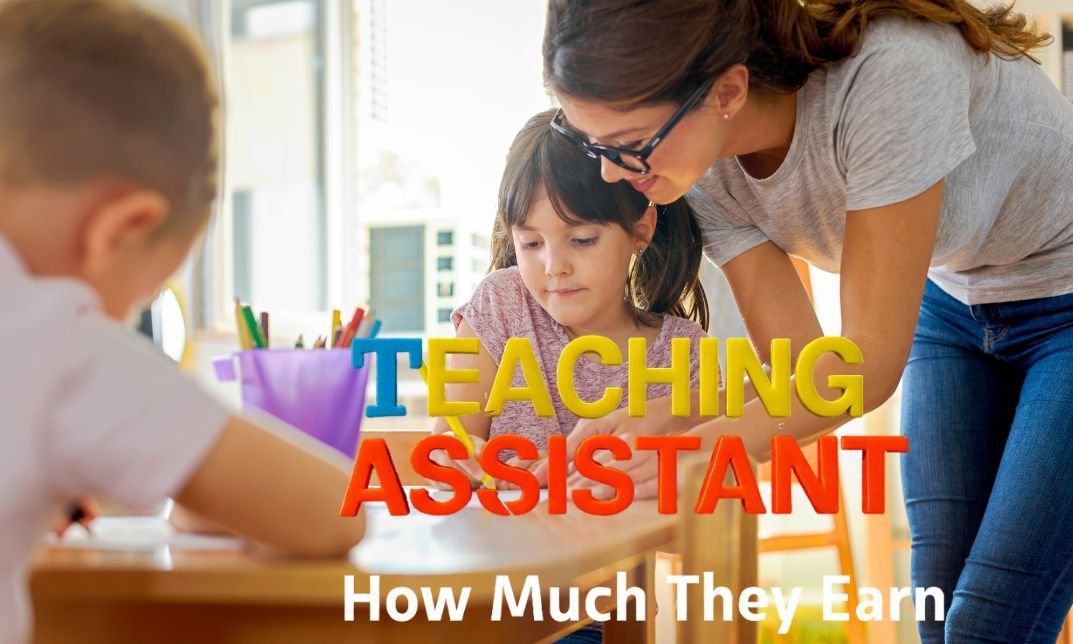No products in the cart.
If you are asking, ‘How do I train to become a teaching assistant?’, the answer is simpler than you might think. You don’t need a long list of qualifications or years of study — just the right starting steps. With the basics in place, you can move from learning to working in schools faster than you imagine.
In this article, you’ll discover the GCSEs and basic skills you need, the difference between Level 2 and Level 3 qualifications, how apprenticeships work, and why DBS checks and safeguarding matter. By the end, you’ll have a clear picture of TA training in 2026 and the steps to take if you are planning to start this career.
What Schools Look For (Teaching Assistant Requirements)

Schools want TAs who meet some simple but important requirements. First, you need GCSE English and Maths at grades 9–4. If you do not have these, you can take Functional Skills as an alternative.
Next, schools often ask for a Level 2 or Level 3 TA qualification. Some people choose a Level 3 TA apprenticeship, which lets you earn while you train. This makes the role more flexible if you want to balance work and study.
You must also complete an enhanced DBS check. This is a safety check that shows you can work with children. Along with this, you need basic safeguarding knowledge, which you can learn through short courses.
Finally, schools like to see some real classroom experience. This does not have to be long. Even short volunteering in a local school can help. It shows you are serious and ready to support children in their learning.
How Do I Train to Become a Teaching Assistant?
You have different ways to start your journey as a teaching assistant. Each path fits different needs and goals.
- College course: Start with Level 2 Supporting Teaching and Learning, then move to Level 3 for more skills.
- Apprenticeship: Choose a Level 3 Teaching Assistant Apprenticeship. You earn money while you learn on the job.
- Direct apply + volunteer: Apply with GCSE English and Maths, then grow experience through school volunteering.
Each route builds the skills you need, but the best path depends on your own situation.
Step-by-Step: How to Become a Teaching Assistant (UK)

Here’s a simple guide you can follow to get started as a teaching assistant:
- Check GCSEs: Make sure you hold GCSE English and Maths (grades 9–4) or Functional Skills.
- Pick your route: Choose a Level 2 or 3 TA course, or a Level 3 apprenticeship.
- Get experience: Volunteer one or two mornings a week and ask for a reference.
- Learn safeguarding: Read the basics—know who to report to and what to record.
- Start your DBS: Apply for an enhanced DBS, including the children’s barred list.
- Add CPD: Take one extra course, like phonics, autism/ADHD, behaviour, or first aid.
- Build your CV: Show skills, your course, and any hours completed in school.
- Apply smart: Check council or trust job pages and set up job alerts.
- Prepare for interview: Practise a simple task, behaviour prompts, and safeguarding questions.
- Onboard well: Bring your ID and DBS, check your timetable, and meet the SENCO/DSL.
DBS Check & Safeguarding for Teaching Assistants (Plain English)
Every teaching assistant must complete an enhanced DBS check that includes the children’s barred list. This proves you are safe to work with pupils. Next, you need to learn your school’s safeguarding rules. Always know who to report concerns to and how quickly. Keep your notes clear, short, and stored securely.
Want a deeper understanding of safeguarding children? Check out the Safeguarding Children Training course from Open Learning Academy. It takes about 2 hours 44 minutes, gives you a CPD-certified certificate, and helps you spot abuse, understand laws, and act confidently.
Get Classroom Experience Fast (Even If You’re New)
The best way to start is by helping in a local school. Many schools say yes if you ask to volunteer. This gives you real practice and makes you more confident.
Here’s how you can do it:
- Ask your local school – pop in or email to offer help.
- Support small groups – listen to reading, join phonics, or sit with pupils in maths.
- Keep a short log – write hours, tasks, and skills. Example: “20 hours helping Year 1 with reading.”
- Use it on your CV – schools like to see real classroom practice.
- Build confidence – even a few mornings help you feel ready for the role.
This way, you learn skills quickly and show schools that you are serious about becoming a teaching assistant.
Teaching Assistant Courses & CPD That Help You Get Hired

Extra training makes you stand out when you apply. Short CPD courses show schools that you are keen to learn. They also give you real skills for the classroom.
Here are some top picks:
- Phonics and early reading – help children build strong reading skills.
- Autism and ADHD awareness – learn simple ways to support every child.
- Behaviour support basics – use calm steps to manage tricky moments.
- Paediatric first aid – feel ready and confident in an emergency.
These courses fit around your time. They also give you quick wins for your CV and interview answers. If you’re looking for affordable, flexible CPD courses, Open Learning Academy offers a wide range designed for teaching assistants at every stage.
Funding & Costs for TA Training (Keep It Simple)
Training to be a teaching assistant can fit different budgets. The good news is, you have several ways to manage costs:
- Apprenticeship – your training is fully funded, and you earn a wage while you learn. It’s a great way to start without debt.
- College courses – many local colleges offer Level 2 or Level 3 TA courses. You can apply for adult-learning funding, bursaries, or instalment plans to make it affordable.
- Government support – if you are on Universal Credit or benefits, you may qualify for extra help with fees.
- School support – once hired, many schools cover the cost of short CPD courses. Some even pay for full training days to help you grow.
- Free options – you can also find free online CPD tasters or safeguarding modules to boost your CV.
By mixing funded routes with school support, you can reduce costs and still build strong skills for your TA journey.
Build a Job-Ready Teaching Assistant CV (Fast Wins)
Your CV is your first chance to show schools you are ready. Keep it clear, short, and easy to read. Here’s how to do it:
- Start with your school experience – write about volunteering, placements, or any time you helped children. Even helping with reading groups or after-school clubs counts.
- Add your courses and training – include things like safeguarding, phonics, autism/ADHD support, or first aid. Schools love to see that you have started learning already.
- Show your soft skills – write that you can stay calm, explain things clearly, and manage behaviour in a kind way.
- Keep it short and tidy – one page is enough. Use clear headings and bullet points so it is easy to scan.
- Match the job ad – read the school’s advert and use the same words to describe your skills. For example, if they ask for “phonics,” make sure you include it.
- Add a short personal touch – write one line about why you love working with children. For example: “I enjoy helping children grow in confidence and learn new skills.”
- Include referees if possible – a teacher or school where you volunteered can make your CV stronger.
When your CV looks neat and shows real school experience, headteachers will want to meet you.
Teaching Assistant Interview Prep (What to Expect)
Interviews for teaching assistants often feel a little different from other jobs. Schools want to see how you work with children, not just how you answer questions. Here’s what you can expect:
- A short classroom activity – you may help with phonics, reading, or supporting a small group in maths.
- A safeguarding question – you will explain who you report concerns to and what notes you must keep safe.
- A behaviour prompt – you may be asked how you would keep children calm, focused, and ready to learn.
- Teamwork and flexibility – expect a question about working with teachers and supporting children with different needs.
- Why you want the role – be ready to share a simple reason, like enjoying helping children learn and grow.
Where to Find TA Jobs & Set Alerts
Finding teaching assistant jobs is easier when you know where to look. Start local, then branch out online:
- Council and academy trust job pages – most schools list vacancies here first, so check often.
- School websites and weekly bulletins – schools post TA jobs directly, so visit their sites every week.
- Set email alerts – use sites like Indeed, Tes, or council portals to get “Teaching Assistant” jobs near your postcode.
- Ask in schools – some smaller schools advertise only on notice boards or in local newsletters.
- Stay ready with your CV – jobs fill fast, so keep your CV updated and ready to send.
Progression: HLTA & Beyond (Career Growth)
When you ask, how do I train to become a teaching assistant, it helps to also think about what comes next. Many TAs move forward by building skills and aiming for higher roles.
- HLTA (Higher Level Teaching Assistant): You can lead groups, support lessons, and even cover classes for short periods.
- CPD first: Add short courses like phonics, SEND, or behaviour. These build your confidence and your CV.
- Apply for HLTA assessment: Once ready, you can prove your skills and step into a higher pay band.
- Beyond HLTA: Some TAs later move into specialist areas like SEN support, behaviour mentoring, or pastoral care.
- Teacher training: With the right qualifications and experience, you can also train as a teacher in the future.
FAQs — How Do I Train to Become a Teaching Assistant?
Q1: What GCSEs do I need to be a TA?
You usually need GCSE English and Maths at grades 9–4 or Functional Skills.
Q2: Do I need a course to start?
Yes, most schools ask for a Level 2 or Level 3 TA course or apprenticeship.
Q3: Can I train while I work?
Yes, the Level 3 Teaching Assistant apprenticeship lets you earn and learn at the same time.
Q4: Do I need a DBS check?
Yes, you need an enhanced DBS with the children’s barred list to work in schools.
Q5: How do I get experience?
Volunteer in a local school for a few mornings to build skills and get a reference.
Q6: Can I move up after becoming a TA?
Yes, you can progress to HLTA, specialist support roles, or even train as a teacher.
Ready to Train as a Teaching Assistant?
If you’re ready to start your journey, the Teaching Assistant Course from Open Learning Academy is a great way to build the right skills and confidence. The course is CPD-certified, flexible enough to fit around work or family life, and designed to give you practical knowledge you can use in the classroom. From safeguarding to behaviour support, it helps strengthen your CV and makes you stand out when applying for TA roles.




